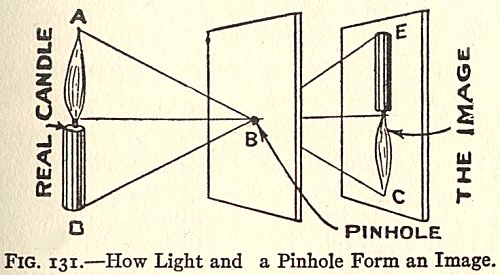Camera Obscura
Today, cameras without film. The University of Houston's College of Engineering presents this series about the machines that make our civilization run, and the people whose ingenuity created them.
We've recently been seeing articles by historians who believe that many of the old masters used a mechanical aid for their painting -- something that reported the scenes with greater precision than their own eyes would have. Philip Steadman's new book, Vermeer's Camera, analyses ten paintings. Each shows exactly what one would've seen from a single point. These are literally views through a pinhole camera. They could be photographs.
So let's look at the word camera. It's Latin for a large vaulted room. From camera we get the word chamber. (A comrade is literally someone who sits in the same room with us.) We take our word camera from an ancient device, perhaps the very device used by Vermeer, called a camera obscura
-- literally, a dark room.
Imagine a totally dark room with a tiny hole through one wall. That hole projects an accurate image of the outside world onto the opposite wall. Without film, we can't really take a picture with it, but we can trace the image with a pen. Aristotle was familiar with that idea, and medieval writers had a lot to say about it.
When I was young, photographic film was pretty slow, and it came in large sizes. We used the camera obscura idea to make something called a pinhole camera. We'd punch a pinhole in one end of a shoebox and mount film on the opposite end, with everything sealed up tightly. Then we'd point the box at a subject, uncover the pinhole for just a moment, and we'd get a passable photograph.
Of course no one put film in a camera until the nineteenth century, but cameras had lenses as early as the sixteenth century. Kepler, who used one with a fairly complicated lens system to make solar observations in 1600, coined the term camera obscura.
The age of optical instruments was then upon us. Now we would see telescopes and microscopes, as well as elaborate camera obscuras. We also began seeing remarkable improvements in the way painters handled perspective. Vermeer lived at the very apogee of this optical renaissance.
Thus photography did not have to fight for acceptance the way so many inventions must. The camera itself had been highly sophisticated for two hundred years and just waiting for someone to find a way to record a picture automatically. But that couldn't happen until we had eighteenth-century improvements in chemistry.
French lithographer Joseph Niépce finally made the first photograph in 1826. It was an eight-hour exposure of the view from his window, formed out of hardened bitumen on a pewter photographic plate. It'd taken Niépce ten years of experimentation, but he provided the long-awaited solution for a long-standing puzzle. After two thousand years, he finally provided film for the camera obscura.
Yet that was two centuries after Vermeer had shown us his beautiful views of domestic Dutch life -- haunting, luminescent, and photographically precise.
I'm John Lienhard, at the University of Houston, where we're interested in the way inventive minds work.
(Theme music)
Newhall, B, The History of Photography. New York, The Museum of Modern Art, 1964.
P. Steadman, Vermeer's Camera: Uncovering the Truth Behind the Masterpieces. New York: Oxford University Press, 2001.
For the art of Vermeer, see: Vermeer, Jan
This is a greatly revised version of Episode 124.

The pinhole camera and camera obscura principle illustrated in 1925, in The Boy Scientist.